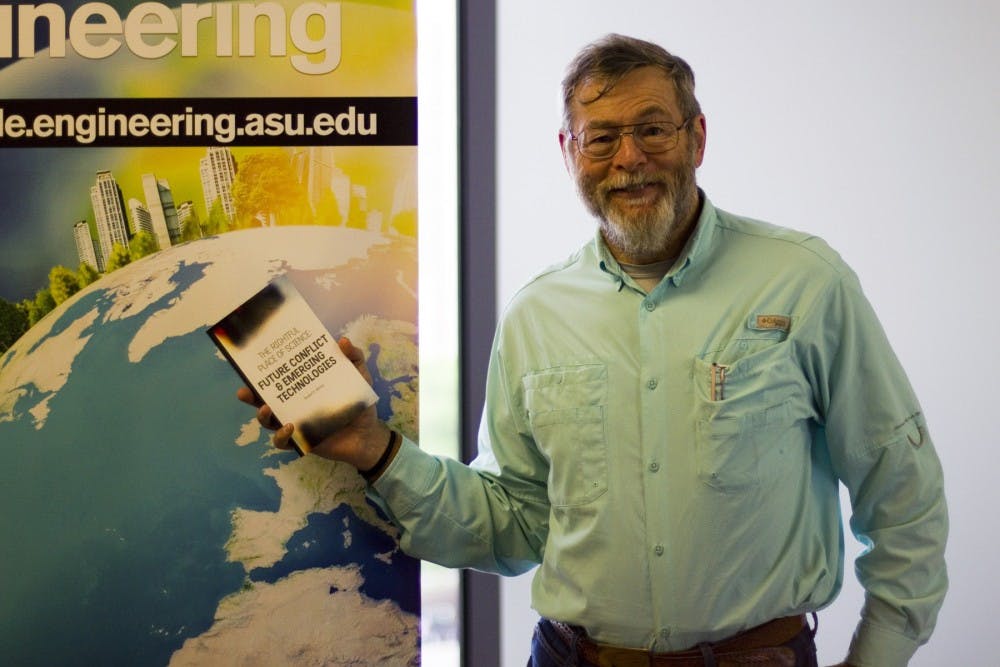Delicacy doesn't come to mind when describing war, but when balancing military technology and ethical responsibility, meticulous planning is key.
This is a topic that ASU Professor Brad Allenby explores in depth throughout his latest book, "The Rightful Place of Science: Future Conflict & Emerging Technologies."
Allenby said he set out to provide an answer to an increasingly important question: What will the future of conflict look like?
His thesis, he said, is that as enemies of the U.S. evolve their methods of inflicting damage, the U.S. will adapt.
"There's no geographic limitation to where a terrorist might strike, which means that the idea that you should only use lethal force in a particular area or battle space might be obsolete," Allenby said.
Technology has by and large leveled the playing field, lowering the cost of entry into international conflict.
"Drones are able to attack combatants in ways that tend to create minimal damage to civilians and to civilian infrastructure," Allenby said.
However, drone technology may have more of a role in data gathering than in active conflict, said Daniel Rothenberg, co-director of the Center on the Future of War.
Rather than become tools of destruction, Rothenberg said their ability to stay aloft for multiple days and function autonomously makes them ideal for reconnaissance. In this way, the U.S. can extend its ability to detect threats while still maintaining accordance with many of the laws governing war.
But the bulk of these laws were written in the first half of the twentieth century, a time when warfare was limited to the number of boots a nation could get on the ground. Allenby said these laws will have to change to reflect the new types of attacks.
"There's a question of what constitutes an attack," Allenby said. "If I go into the financial infrastructure of the U.S., and I put software bombs into it that could destroy much of the data that we rely on for our financial transactions, is that an attack? At what point does that become an attack?"
While Allenby said he hopes that the U.S. will redefine its method of dealing with these threats, he also noted that a new definition is only a small part of a potential American response. Equally important, he said, is maintaining the sort of personnel and involvement necessary to counteract these threats.
"The military today needs expertise in a lot of very different fields," he said. "They need cyber experts. They need robotics experts. The problem is that there's very little incentive for experts in these lucrative fields to seek employment with the military. If some guy's having a good time eating Skittles and drinking Coke in Silicon Valley, they're not going to be really excited about going through basic training."
In order to increase military involvement, Allenby said he would consider the possibility of reinstituting a draft, with some slight modifications.
"Politically, a draft is very difficult, but we also know that the civilian population is growing further and further away from the military population," Allenby said. "One of the things that I talk about in the book is that we should consider drafting old people instead of young people."
While the idea holds obvious appeal with those knee deep in textbooks, some young people may not view the idea so favorably.
Emma He, a neurobiology student, said that drafting people out of the U.S. workforce's most productive age group would likely arouse a vocal reaction from the private sector.
Allenby's rational is that as technology increases, the need for physically fit personnel to wage battles decreases. Instead, having a draft not only increases the number of experts in the various emerging fields, but it also forces the public to maintain an active interest in military activity, he said.
"The Rightful Place of Science: Future Conflict & Emerging Technologies" was published Sept. 16, and can be bought in paperback and hardcover on Amazon.com.
Reach the reporter at sdeadric@asu.edu or follow @deadrick_sam on Twitter.
Like The State Press on Facebook and follow @statepress on Twitter.




